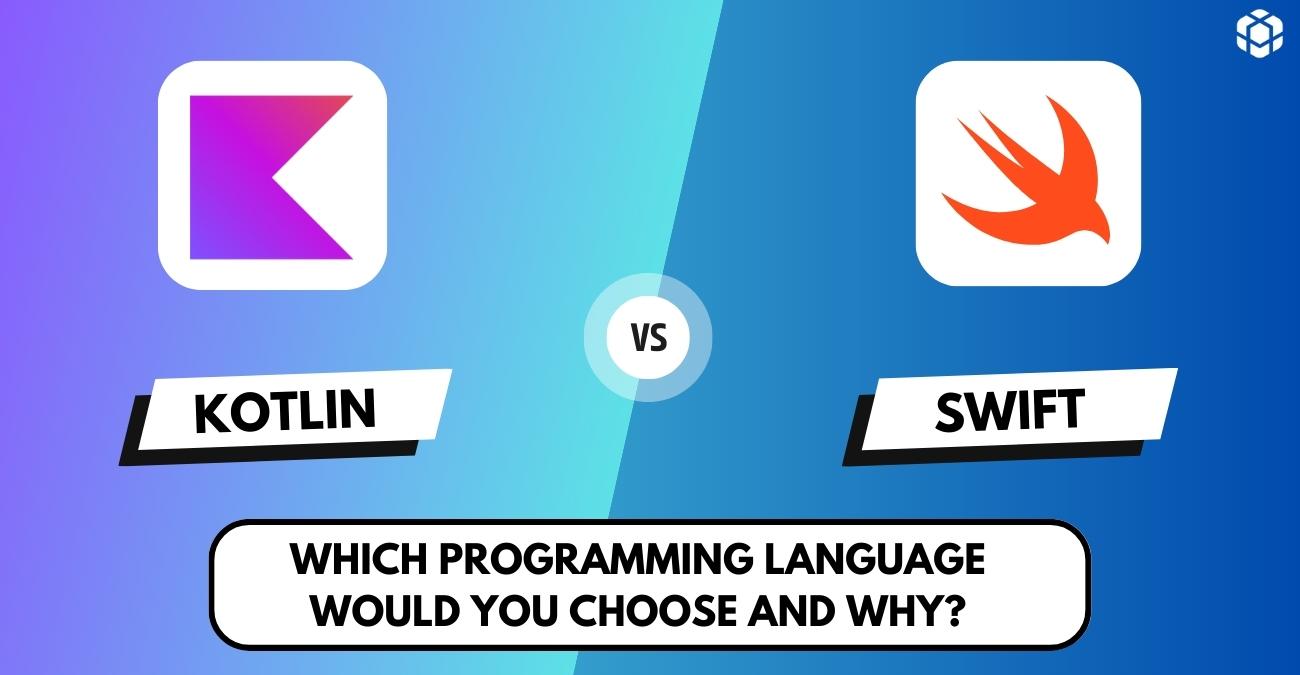
Building a mobile app and stuck choosing between Kotlin and Swift? You’re not alone. In fact, as of 2021, more than 50% of professional developers favored one of these languages for mobile development, according to the Stack Overflow Developer Survey.
Your choice of language between Kotlin and Swift can significantly impact your app’s success. That’s why it’s vital to understand the differences, especially when it comes to performance.
Let’s dive into the Kotlin vs Swift debate so that you can find the best choice for your app. Ready? Let’s dive in!
What Is Kotlin?
Before 2019, Java was the go-to language for Android app development. But everything changed when Google announced a new favorite, Kotlin, in May 2019. Why did this happen? Here’s a quick backstory.
Kotlin was introduced by a team at JetBrains led by Dmitry Jemerov in July 2011. They wanted a solution to problems they had with Java. So, they made Kotlin open source under the Apache 2 license for all developers in February 2012. The name ‘Kotlin’ was inspired by Kotlin Island, near St. Petersburg, Russia.
Since then, Kotlin has become more popular. The TIOBE index, which ranks languages by popularity, shows Kotlin at 35 and Java at 3. Going forward, Kotlin is set to grow even more. It’s a reliable language that makes app development easier and user experience smoother.
Benefits of Kotlin
Choosing Kotlin for your Android app development comes with some noteworthy advantages. Let’s have a look at some of its benefits:
- Concise Code – Kotlin requires less boilerplate code compared to Java. This means you can write more functional code in fewer lines.
- Interoperable with Java – It is 100% interoperable with Java. You can use Java libraries and frameworks in Kotlin seamlessly, easing the transition for developers.
- Safety Features – Kotlin’s design minimizes common programming errors, reducing the chance of crashes and system failures. Its null safety feature helps prevent pesky NullPointerExceptions.
- Built-in Coroutines – Kotlin’s Coroutines help in writing asynchronous code more straightforwardly.
- Improved Efficiency – Kotlin lets you work smarter, not harder. Thanks to its expressive syntax, you can develop faster, squish bugs, and get your app out there in record time.
Drawbacks
Since you’re now aware of the benefits of Kotlin, it’s essential to remember that every product comes with its drawbacks. Here are a few of these to consider when making your decision:
- Fewer Third-Party Tools – While Kotlin offers concise code and great interoperability with Java, its newer status means there might be fewer extra tools and libraries available compared to more established languages like Java or Python.
- Performance Concerns – Kotlin is an excellent language overall, but it might not match Java’s performance levels in certain cases. If speed is crucial for your app, this is worth considering.
- Smaller Community – Kotlin is gaining popularity, but it doesn’t have as vast a developer community as Java or Python. This could mean finding support and help might be a bit harder.
- Limited Usage in Some Areas – Kotlin shines in Android app development, but its usage in other fields might be less widespread.
What is Swift?
Turning our attention to Swift now, let’s see what it offers. Developed by Apple, Swift is a perfect fit if you’re dreaming of crafting applications for IOS platforms.
The origin story of Swift starts in July 2010. A forward-thinking guy named Chris Lattner came up with a plan. He envisioned a language that was simpler and safer to use than the then-favored Objective-C. Following this vision, he brought Swift to life.
Swift isn’t a language created in isolation. It cleverly borrows useful traits from a variety of other languages, such as Objective-C, Rust, Haskell, Ruby, Python, C#, and CLU.
Think of Swift as a “best of” compilation, cherry-picking handy features from each of these languages.
Swift first stepped into the limelight in 2014. Remember the official app for Apple’s annual Worldwide Developers Conference (WWDC)? That was built entirely using Swift, marking the language’s real-world debut. It wasn’t just an experiment anymore but a fully-fledged player in the world of programming.
As we look at Swift’s popularity, it’s clear that it’s a hit among developers. On the TIOBE Index, a well-known barometer for programming languages, Swift comfortably sits at the 20th spot. And just for context, that’s a whole 15 places ahead of Kotlin!
Key Advantages Of Swift
Now that we’ve got a handle on what Swift is. Let’s look at some of its standout features:
- Open Source – Swift is free and open to all. This encourages a broad, active community of developers who are constantly improving it. In fact, Senior VP of Software Engineering at Apple, Craig Federighi, said, “We saw open sourcing as a critical element to make Swift reach its potential to be the language, the major language for the next 20 years of programming in our industry.”
- Easy to Learn – With a clean, intuitive syntax, Swift is a good pick for beginners.
- Low Maintenance – Swift needs less upkeep. You won’t have to juggle separate libraries for script manipulation and forward compatibility.
- Safety Features – Swift eliminates entire classes of unsafe code. By default, Swift objects can never be nil. The compiler will actually stop you from making or using a nil object with a compile-time error.
Key Disadvantages
As we’ve discussed the positive aspects, it’s only fair that we also touch on some disadvantages of Swift:
- Youthful Language – Swift is relatively young, especially compared to veterans like Objective-C, which has been around since the 1980s. This can sometimes bring challenges due to less extensive resources and tested solutions.
- Limited Interoperability with Third-Party Tools – Finding the right tools for certain tasks can be tricky with Swift, as its interoperability with third-party tools and IDEs is not always seamless.
- Lack of Support for Earlier iOS Versions – If your app needs to support older iOS versions, Swift might not be the best choice. It’s not fully compatible with earlier iOS versions.
- Limited Talent Pool – Swift’s talent pool isn’t as extensive as other languages. According to the latest StackOverflow Developer Survey, only 5.1 percent of the 83,053 respondents use Swift. This can make finding experienced Swift developers a challenge unless you’re using Codesy’s platform, which connects you to the Swift developers in 24 hours.
Key Differences Between Kotlin vs Swift
Now that you’ve got the basics, it’s time to dig deeper. After all, you want to make an informed decision between Kotlin and Swift.
So, here are some key differences that might tip the scales for you.
1. Development
Kotlin is the language of choice for Android development. If you’re developing an app for the Google Play Store, Kotlin is your best friend. It integrates nicely with Android Studio IDE and gives you the ability to utilize Android-specific libraries and frameworks to the fullest.
Flip the coin, and you find Swift shining in the Apple universe. Designed specifically for iOS, macOS, watchOS, and tvOS app development, Swift is a perfect match for the Xcode IDE and iOS SDK.
2. Memory Management
Kotlin relies on a garbage collector to manage memory, similar to Java. While this automatic memory management simplifies coding, it can sometimes lead to performance issues if not handled correctly.
On the other hand, Swift uses Automatic Reference Counting (ARC) for memory management, which can result in more predictable performance.
3. Data Classes
Kotlin introduces data classes, which automatically generate common methods like equals(), hashCode(), and copy(). This significantly simplifies the process of creating classes to hold pure data. In comparison, Swift doesn’t have a direct equivalent to Kotlin’s data classes.
4. Function Implementation
Although the functions of Kotlin and Swift share some similarities, there are a few important distinctions to be made in the Kotlin vs Swift debate.
In Kotlin, variables don’t use an underscore (_) as a prefix. Instead, the language focuses on the usage of lambda expressions and higher-order functions. These allow for a more streamlined and adaptable code, making Kotlin a favored choice for those seeking a functional programming style.
On the flip side, Swift embraces the underscore (_) as a prefix for variables. It leverages closures, which are unnamed functions capable of capturing and referring to values from their surrounding context. Similar to Kotlin, Swift also supports higher-order functions, but it brings more flexibility with closures.
5. Extensions
Swift takes the lead when it comes to extensions. Swift allows developers to add extra functionality to existing code, providing a level of flexibility and customization.
In contrast, Kotlin takes a more rigid approach. It doesn’t allow for changes or additions to existing code, limiting developers to using functions as they’re initially defined.
6. Error handling
Kotlin’s design aims to eliminate null references from your code, reducing the chance of unexpected null pointer exceptions.
However, Swift uses optional types to handle the absence of a value. Variables are either fully functional objects or nil. This adds a layer of safety to your code, minimizing unexpected crashes.
7. Structs
In Kotlin, there’s no direct equivalent to Swift’s structs. Instead, you would typically use classes or data classes to accomplish similar tasks.
Whereas, in Swift, structs are a powerful tool, allowing developers to create their own custom data types. Unlike classes, structs are value types, not reference types, which can make them a safer option in some situations.
Similarities Between Kotlin and Swift
Even though Kotlin and Swift have some differences, they share a lot in common. Here’s what makes them alike:
- Both Kotlin and Swift treat functions as first-class citizens.
- Kotlin and Swift have similar coding constructs for controlling the flow of a program.
- The class systems in Kotlin and Swift are very alike.
- An interesting shared feature is the use of class extensions.
- Kotlin and Swift have similar built-in data structures, such as arrays, sets, and dictionaries.
Kotlin vs Swift: Which to Choose?
Making your choice between Kotlin and Swift isn’t as hard as it sounds. It’s all about your target platform.
Are you dreaming of an Android app? Go for Kotlin. Google loves it, and so will you. It’s a language built with Android in mind, so it’s a match made in heaven.
Planning for iOS? Then Swift should be your new best friend. Made by Apple for Apple, it’s got everything you need to create that stunning iOS app you’re thinking about. Both Kotlin and Swift are solid choices. They’re modern, powerful, and packed with features.
But wait, finding expert developers for these languages might be a challenge, but fear not because we have the best Kotlin and Swift developers ready to join your project within 24 hours. So, pick the one that’s right for you and turn your app idea into a reality!





